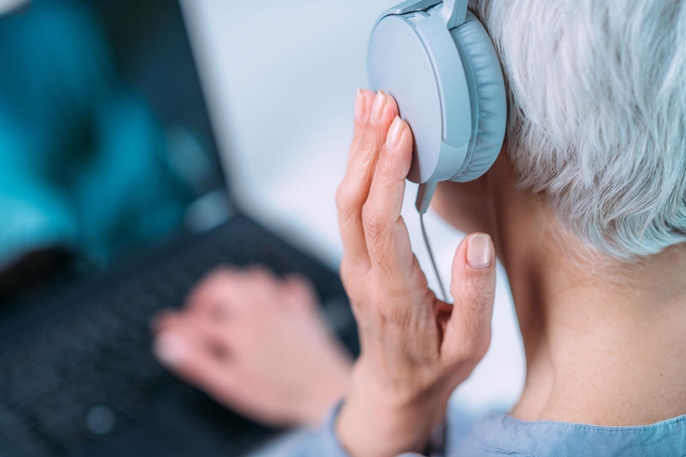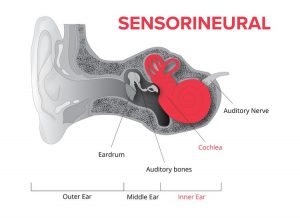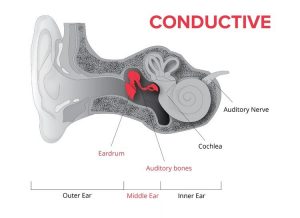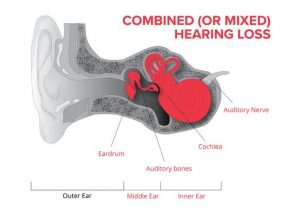Types of Hearing Loss
Sensorineural Hearing Loss
Sensorineural hearing loss, or SNHL, is the result of damage to the hair cells located in the inner ear (cochlea). Soft sounds may be hard to hear. Even louder sounds may be unclear or may sound muffled.
SNHL is the most common type of HL. SNHL is a progressive disorder which in most cases is not treatable with medication or surgery. Most patients with SNHL benefit significantly with hearing aids.
Causes of Sensorineural Hearing Loss
This type of hearing loss can be caused by the following things:
- Aging (Presbycusis)
- Noise Exposure
- Hereditary Issues
- Certain Medications (ototoxicity)
- Congenital problems
- Head trauma
- Increased risk associated with certain medical conditions e.g. diabetes and cardiovascular issues.
Conductive Hearing Loss
A conductive HL is the result of problems that interfere with the transmission of sound through the ear canal, eardrum or middle ear space.
Conductive hearing loss is often treatable with medication or surgical procedures.
Causes of Conductive Hearing Loss
This type of hearing loss can be caused by the following:
- Fluid in your middle ear
- Ear infection, or otitis media.
- Poor Eustachian tube function. The Eustachian tube connects your middle ear and your nose. Fluid in the middle ear can drain out through this tube. Fluid can stay in the middle ear if the tube does not work correctly.
- Perforation (hole) in your eardrum.
- Benign growths in middle ear. Often seen in surfers or individuals routinely exposed to cold water.
- Earwax (cerumen) blocking the ear canal.
- Infection in the ear canal, called external otitis. You may hear this called swimmer’s ear.
- Foreign body in ear canal. An example might be if your child put a pebble in his ear when playing outside.
A problem with how the outer or middle ear is formed. Some people are born without an outer ear. Some may have a deformed ear canal or have a problem with the bones in their middle ear.
Mixed Hearing Loss
Sometimes, a conductive hearing loss happens at the same time as a sensorineural HL, or SNHL. This means that there may be damage in the outer or middle ear and in the inner ear or nerve pathway to the brain. This is a mixed hearing loss.
Causes of Mixed Hearing Loss
Anything that causes a conductive hearing loss or SNHL can lead to a mixed hearing loss. An example would be if you have loss because you work around loud noises and you have fluid in your middle ear. The two together might make your hearing worse than it would be with only one problem.
Hearing Loss Facts
-
48 million individuals in the United States have some form of hearing loss
People are oftentimes surprised by this number, and they should be—this is 20 percent of the total US population! Expressed a different way, on average, one out of every five individuals you encounter will have some degree of difficulty hearing.
-
More than 30 million Americans younger than 65 have hearing loss
Out of the 48 million individuals that have HL in the US, it’s common to presume that the majority are 65 and older.
But the truth is the reverse.
For those troubled with HL in the US, approximately 62 percent are younger than 65.
-
1 billion teens and young adults are in danger of developing hearing loss worldwide
As reported by The World Health Organization:
“Some 1.1 billion teenagers and young adults are at risk of hearing loss due to the unsafe use of personal audio devices, including smartphones, and exposure to damaging levels of sound at noisy entertainment venues such as nightclubs, bars and sporting events. Hearing loss has potentially devastating consequences for physical and mental health, education and employment.”
-
Any sound in excess of 85 decibels can cause damage to hearing
A typical conversation is about 60 decibels and city traffic is around 85 decibels. These sounds probably won’t damage your hearing.
Motorcycles, on the other hand, can reach 100 decibels, power saws can reach 110 decibels, and a rowdy rock concert can achieve 115 decibels. Teenagers also tend to listen to their iPods or MP3 players at around 100 decibels or higher.
-
26 million individuals between the ages of 20 and 69 are afflicted by noise-induced hearing loss
According to the National Institute on Deafness and Other Communication Disorders (NIDCD), 15 percent of Americans (26 million people) between the ages of 20 and 69 suffer from HL as the result of exposure to loud noise.
So, while growing old and genetics can cause hearing loss in older adults, noise-induced hearing loss is equally, if not more, dangerous.
-
Each person’s hearing loss is unique
No two people have exactly the same hearing loss: we all hear an assortment of sounds and frequencies in a somewhat different way.
That’s why it’s crucial to have your hearing examined by a highly trained hearing care professional. Without specialized testing, any hearing aids or amplification products you buy will most likely not amplify the proper frequencies.
-
On average, people wait 5 to 7 years before seeking help for their hearing loss
Five to seven years is a very long time to have to battle with your hearing loss.
Why do people wait so long? There are in fact several reasons, but the main reasons are:
- Less than 16 percent of family doctors test for HL.
- HL is so gradual that it’s hard to notice.
- HL is often partial, which means some sounds can be heard normally, creating the impression of healthy hearing.
People believe that hearing aids don’t work, which brings us to the next fact.
-
Only 1 out of 5 people who could reap the benefits of hearing aids wears them
For every five people who could live better with hearing aids, only one will actually wear them. The main explanation for the disparity is the incorrect presumption that hearing aids don’t work.
Perhaps this was true 10 to 15 years ago, but most certainly not today.
The evidence for hearing aid effectiveness has been thoroughly reported. One example is a study managed by the Journal of the American Medical Association, which found three popular hearing aid models to “provide significant benefit in quiet and noisy listening situations.”
-
More than 200 medications can trigger hearing loss
Here’s a little-known fact: certain medications can injure the ear, resulting in hearing loss, ringing in the ear, or balance disorders. These medications are considered ototoxic.
In fact, there are more than 200 known ototoxic medications. For more information on the specific medications, visit the American Speech-Language-Hearing Association.
-
Professional musicians are 57 percent more likely to suffer from tinnitus
In one of the most extensive studies ever carried out on hearing disorders affiliated with musicians, researchers discovered that musicians are 57 percent more likely to be affected by tinnitus—persistent ringing in the ears—as a result of their work.
If you’re a musician, or if you attend live events, protecting your ears is vital. Talk to us about customized musicians earplugs that ensure both protected listening and preserved sound quality.
Source: https://www.hahc.net/10-surprising-facts-about-hearing-loss/
Learn from our blog!

What to Expect from Over-The-Counter Hearing Aids
In 2017, Congress passed a law for over-the-counter hearing aids to be sold for individuals with mild to moderate hearing loss. Over-the-counter hearing aids will be sold in stores and online without a medical evaluation or hearing test from an audiologist. This will...

MEDICARE & HEARING AIDS
In 2021 there was discussion about the possibility of Medicare paying for hearing aids. This was actually part of the proposed coverage under the Build Back Better Bill. This bill was initially a $3.5 trillion dollar proposal which included Medicare coverage for...

Listen Up While Masking Up
We always suggest to our patients that they wear their hearing aids as often as possible. But what we have found is many of them are not wearing their hearing aids when they leave their house anymore. Why? Because they are nervous about losing their hearing aids when...

Hearing Aids Are Like Running Shoes
This past summer I started to run. I wanted to improve my health and figured running would be easy to incorporate into my afterwork routine. So, one day I strapped on my sneakers and off I went. In those first few weeks of running, everything hurt. But the more I ran...

Why You Need the Bells & Whistles
A frequent comment we hear from patients is that they just want a simple hearing aid and they don't need all the “bells and whistles.” But, what are the “bells and whistles?” I think most people are referring to Bluetooth; however, almost every hearing aid on the...

Can I Have My Hearing Tested Online or at My Home?
Although it may sound more convenient to use online testing or in home hearing testing, there are many drawbacks. In person testing in our office and most Audiology offices is conducted in a sound treated booth to ensure results are not impacted by environmental...



